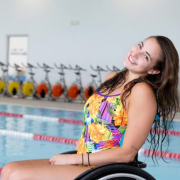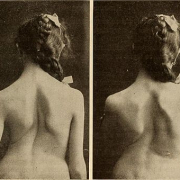Giulia, the story of a record-breaking Paralympic champion
It was her smile that first made us want to hear her story.
Giulia Terzi, 26, recently came back from the Tokyo Aquatics Centre with five Olympic medals from five races (two golds, two silvers and a bronze) — a new Italian and European record. Within the space of just weeks, she was also awarded, with top marks, a degree in law, to add to a previous one in political science. All in all, she is a real wonder woman, blessed with truly enviable determination and perseverance.
“When I asked her how all this makes her feel,” says Isico physiotherapist Martina Poggio, who had the privilege of interviewing her, she said: “It’s like a dream that I am still struggling to take in. It is the culmination of countless sacrifices. Each time I pick up my medals and look at them, I am reminded that hard work, sacrifices and everything you have to give up really are worth it, and can take you to the top, even though it can be hard to believe it at the time.”
Giulia also explained: “I went through some very difficult years. I was diagnosed with congenital scoliosis at the age of just 3 years, and therefore embarked on an exercise-based treatment at a very young age. When I was 14 years old, I spent 9 months wearing a plaster cast and that was followed by 4 years of bracing. Between 2015 and 2018, I had three operations, and as a result of medullary complications that arose subsequently, I am now in a wheelchair. I have found that the secret is to have the right people around you, trust those who love you and, whenever you need it, ask for help. No one is invincible and some days and periods are more difficult than others, but with the love and support of family, friends and the right people, you can overcome anything! My parents and siblings have been crucial in helping me get through the hard times, I owe them so much!”
Giulia has a great Instagram profile, full of content, where she writes: “In my case, scoliosis has meant casts, braces, three operations, and titanium rods in my back with all that that entails. But, more than all of this, the word scoliosis, to me, means lots of other things as well. It means a bond, that special bond created through the looks you exchange with those around you, who see how hard you have to fight every single day, fight back tears when you are being taken off for surgery, but also look at you with so much pride whenever, despite everything, you achieve an objective. Scoliosis means pain, sleepless nights spent trying to sleep on a table or the bedroom floor. It means resilience, because all of this has, after all, allowed me to develop into a much stronger person, teaching me to endure fatigue and to pour ever more determination into making my dreams come true, because nothing has been allowed to get in the way of those! It also means love, for the people who have been by my side since the start, and ice creams that could not be enjoyed outdoors, in a park, but had to be eaten in a hospital bed, laughing about it, like it was the normal thing to do. When you find yourself facing a difficult situation, it’s so easy to let yourself get dragged down by negative comments, words and fears, but in the end, it is the energy and determination with which you pick yourself up that shows you for the person you are and that, whatever your problems, that must always win through.”
I prefer to quote Giulia’s exact words because I really believe that only someone who has gone through this experience themselves can really understand what it is like for our youngsters having to wear a brace day after day, rising bravely to the challenges that scoliosis brings” Martina Poggio says.
“I wanted to turn a spotlight on Giulia, because she is a great example and her story illustrates perfectly the importance of fighting every day and not giving up on your dreams.”
The scientific literature reports perioperative complication rates of between 5% and 20%, depending on the surgical approach and the type (severity) of the complications themselves (Weiss, HR., Bess, S., Wong, M.S. et al. Adolescent idiopathic scoliosis – to operate or not? A debate article. Patient Saf Surg 2, 25 (2008). https://doi.org/10.1186/1754-9493-2-25). The rate of neurological complications after posterior fusion is 0.32%.
Unfortunately, Giulia is part of that very small percentage, but her case is a crucial reminder of the fact that every difficulty can also bring new opportunities. This is a message aimed both at those youngsters who, through exercises, are trying to make sure their condition does not worsen to the point of needing bracing treatment, and also at those who are wearing a brace in the hope of managing to avoid surgery.
“Another important aspect of this story, worth underlining, is the important role played by sport,” Poggio points out. “As Giulia says, “sport is fundamental, because it helps you experience lots of different worlds and get to know loads of people. But it also presents you with many challenges and helps you overcome barriers. My particular scoliosis-related barrier was the idea that “I can’t…”.
Instead, what sport teaches you is that you can! And you also learn that this is partly thanks to the support you get from being part of a group that believes in the objective you have set yourself and helps you to achieve it.”
“It can certainly be difficult fitting in sports training, studying and physiotherapy” says Giulia, reflecting on a typical day in her life. “However, I think that health has to be the number one priority and that, to stay fit and well, you need to show the same level of commitment to your treatment as you do to your other pursuits. Studying is another key area that shouldn’t be neglected. Education is crucial when it comes to building your future and chosen career, and studying is clearly the key contributor to this objective. The trick is to be organized: I do two hours of swimming in the morning, followed by a gym or physiotherapy session. Then I go home to study. I do another couple of hours in the pool in the afternoon, and then in the evening it’s back to my books! It’s a tough schedule, but this year I managed to win a gold medal at the Paralympic Games and graduate in law, earning top marks with honours, so all in all I would say that all my sacrifices have paid off!”
Many of our youngsters who do competitive sport are familiar with the challenges Giulia describes. When they are told that they need to wear a brace full time, their main concern is making sure they can go on practising the sporting activity they have dedicated so much to. The physicians at Isico agree that it is hugely important to ensure that wearing a brace does not interfere too much with these young people’s lives. Indeed, everything possible is done to make sure that they can go on training every day, in spite of the treatment they are receiving.
We asked Giulia what advice she has for youngsters dealing with scoliosis and its challenges on a daily basis, and she replied: “Don’t let barriers and prejudice stop you. Unfortunately, you are bound to meet some, but we all have hidden resources. If you can discover those, you can develop into a great man or woman. Learn from your sport, and on difficult days try and find at least one reason to be happy! Everything is easier with a smile on your face!”
We end with another valuable consideration taken from Giulia’s Instagram profile. She says: “I think that you really need to embrace pain fully. Don’t try and block it out: let it in and learn to live with it. It needs to take its time and work in its own way. It has to develop before it weakens. After that, the scars will fade, but only with time. It doesn’t make sense to try and hide them. People can’t always be invincible. Instead, I firmly believe that those who sometimes allow themselves to be fragile are actually stronger.”


